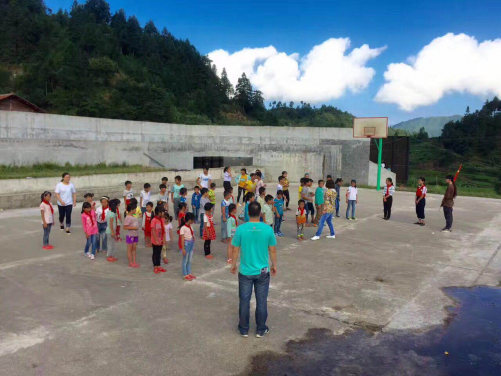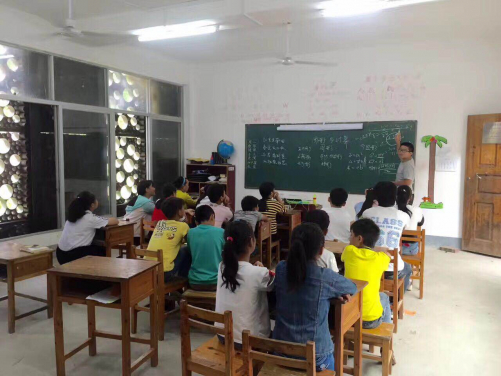Media
HKU’s “Project Mingde” wins the 2018 Architizer A+Awards
09 Sep 2018
Project Mingde from the University of Hong Kong and architect Ms Elisabeth Lee received the “Popular Choice Winner – Architecture + Humanitarianism” in the international 2018 Architizer A+Awards for the design and construction of the Dabao Primary School cum Community Cultural Centre in the remote hillsides of Guangxi, China.
Receiving entries from over 100 countries, the Architizer A+Awards is the largest awards programme promoting and celebrating the year’s best architecture and products. Less than ten percent of all entrants received recognition this year. Professor Ian Holliday, Vice-President and Pro-Vice-Chancellor (Teaching and Learning) of the University of Hong Kong said, “Project Mingde has nearly 15 years of outstanding accomplishment in Mainland China. This award is fitting recognition of the hard work contributed over many years by HKU students, teachers and alumni. We’re very grateful to, and proud of, them all.”
Situated at a remote mountainous area of the northern part of the Guangxi Province, the Dabao Village is home to about 100 families from the ethnic minority group of Yao, who have their very own distinctive dialect and culture. The two simple wooden structures that served as school to over 70 children were over 60 years old and close to collapse. Project Mingde stepped in with full-time students from HKU and industry professionals collaborating to rebuild the school which also serve as a community cultural centre. The Dabao Project provides the much-needed teaching and community facilities to villagers that previously did not exist. Children now have an inspirational space in which they can learn and play and the community has a comfortable area to gather and connect for events, festivals and celebrations, keeping alive the heritage and the spirit of the Yao culture.
The design and construction process was an active dialogue between Dabao villagers and the project team, a reciprocal exchange in culture, knowledge and skills. As the building is situated within the paddy fields on the mountains of Dabao, the design concept structured around the use of layers of walls in addressing the challenges originated from the steep topography of the site. With an abundant supply of bamboo in the area, it is fully made use of and not only acts as a protective barrier from the road outside, but also regulates the transmission of noise and daylight whilst ensuring privacy of occupants at the same time. The use of different diameters and lengths of bamboo tubes responds adequately to the different light requirements of the rooms for their respective functions.
Ms Elisabeth Lee, volunteer architect for the Project, created the architectural design which was transformed into building plans by HKU faculties to be built by the local construction team. Trying to strike a balance between first-class design concepts and the harsh conditions on site, she said, “Blending into the rice paddies and village houses, the Dabao structure uses layered construction techniques and features bamboo as a key element to provide a bright and airy setting, and is designed to merge the building harmoniously with the surrounding landscape.” As a result, the design responds to and shows a deep understanding of the people and place for which it was designed. The outcome of the project is a piece of architecture attuned to its environment and transformed by the obstacles that arose during the process.
Project Mingde is a unique experiential learning programme through which HKU faculties, HKU students, industry professionals, and donors collaborate on real-world projects that address social gaps in rural settings. Under the guidance of the Dabao Project management team, HKU students who participated in the project were involved in every stage, from the feasibility report, project strategy, construction contracts, and construction management, to creating the funding proposal.
The project would not have been so successful without the support from Professor Nicolas Yeung, Professor S. C Wong, Professor Peter Lee and Dr. Ivan Lau, as well as trust from the local government and community. The construction costs were generously funded by the PAN Foundation. Ms Elisabeth Lee was the volunteer architect for the project and student activities were funded by the Lee Hysan Foundation.
For more photos and the video clip, please click here.
Media enquiries:
Ms Anila Ma (Tel: 9328 2666 / Email: anilama@hku.hk)
Communication and Public Affairs Office:
Ms Trinni Choy (Tel: 2859 2606 / Email: pychoy@hku.hk)
Ms Rashida Suffiad (Tel: 2857 8555 / Email: rsuffiad@hku.hk)
Ms Melanie Wan (Tel: 2859 2600 / Email: melwkwan@hku.hk)


